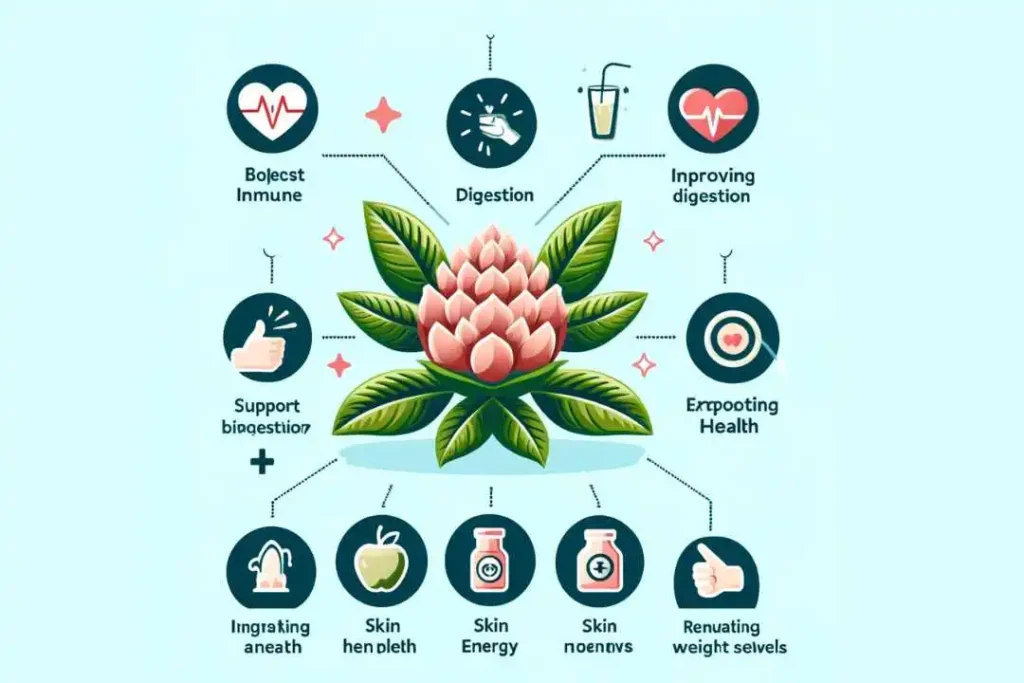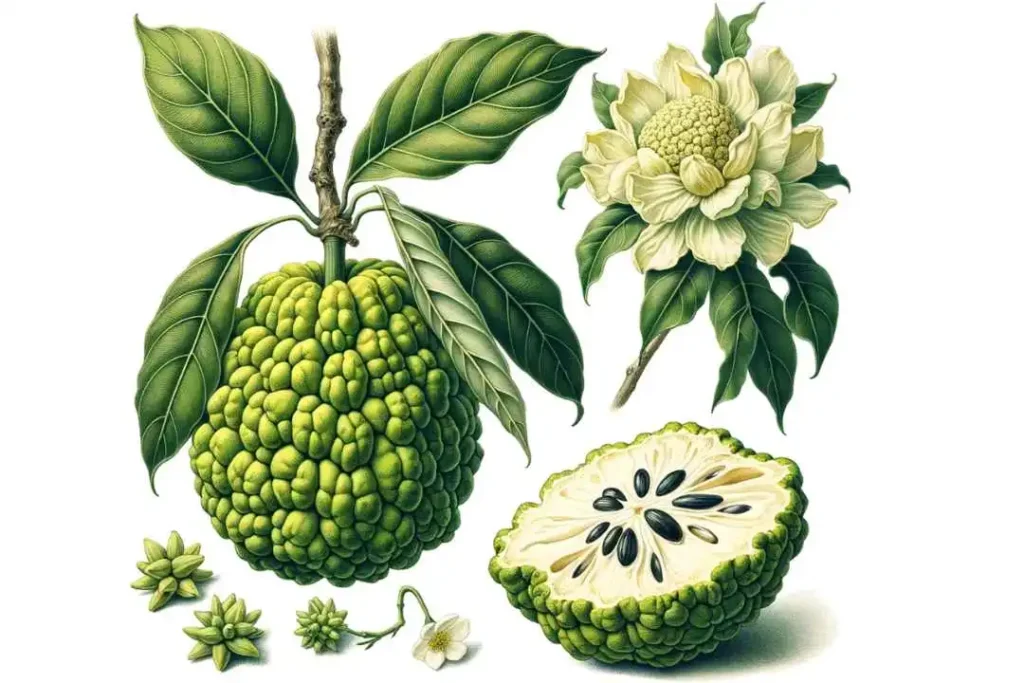What is Anona?
Anona, scientifically known as Annona squamosa, is a remarkable tropical fruit that belongs to the Annonaceae family. This fruit-bearing tree is renowned for producing what is commonly known as the sugar apple, a name that aptly reflects its sweet and creamy nature. Originating from the tropical regions of the Americas, particularly the West Indies and Central America, Anona has spread across the globe, captivating the hearts and taste buds of many. Its allure lies not only in its unique flavor but also in its rich nutritional profile and numerous health benefits. Whether eaten fresh, blended into smoothies, or used in culinary creations, Anona is a versatile and delightful addition to any diet.
What is the Common Name of Anona?
The most prevalent name for Anona is the sugar apple, a title that perfectly encapsulates its sweet, dessert-like qualities. However, this fruit is known by various names around the world, reflecting its widespread cultivation and cultural significance. In English-speaking regions, it is also called sweetsop. In Spanish-speaking countries, it is often referred to as anón or chirimoya, although the latter is also a term used for a different species within the same genus. These names, while diverse, all point to the fruit’s delightful sweetness and creamy texture, making it a favorite among tropical fruit enthusiasts.
What is Anona’s Fruit in English?
In English, the fruit of the Anona tree is commonly known as the sugar apple or sweetsop. These names highlight the fruit’s sugary taste and custard-like consistency, characteristics that have made it a beloved treat in many parts of the world. The term “sugar apple” vividly describes the fruit’s exterior as well, which resembles a scaly green apple. Inside, the flesh is soft, white, and segmented, easily scooped out with a spoon. The combination of its appearance and flavor has cemented the sugar apple as a popular and easily recognizable tropical fruit in English-speaking regions.
What is Another Name for Anona?
In addition to being called sugar apple and sweetsop, Anona is also known by several other names depending on the region and language. One notable name is custard apple, which is used interchangeably for Annona squamosa and its close relatives like Annona reticulata. This name is particularly common in countries like India and Australia. In some parts of the Caribbean and Latin America, Anona is referred to as fruta de condessa or simply anón. These varied names all hint at the fruit’s rich, custard-like texture and sweet taste, underscoring its universal appeal.
What is the Taste of Anona?
The taste of Anona is often described as a symphony of sweet and creamy flavors, akin to a custard dessert. Its flesh is soft, juicy, and slightly grainy, melting in the mouth with a pleasant and refreshing aftertaste. The flavor profile of Anona includes subtle hints of vanilla, pineapple, and banana, making it a complex and delightful experience for the palate. This unique blend of flavors has made Anona a sought-after fruit for both direct consumption and culinary applications. Whether enjoyed on its own or as part of a dish, the taste of Anona is sure to captivate and satisfy.
The Nutritional Profile of Anona

Anona is not only a treat for the taste buds but also a powerhouse of nutrients. This fruit is rich in essential vitamins and minerals, making it a valuable addition to a balanced diet. It is particularly high in vitamin C, which is crucial for boosting the immune system and protecting against illnesses. Additionally, Anona contains significant amounts of vitamin B6, which supports brain health and metabolic functions. The fruit is also a good source of dietary fiber, aiding in digestion and promoting gut health. Furthermore, Anona provides essential minerals such as potassium, magnesium, and iron, which are vital for maintaining overall health and well-being.
Table: Nutritional Value of Anona (Per 100g)
| Nutrient | Amount |
|---|---|
| Calories | 94 kcal |
| Carbohydrates | 23.64 g |
| Protein | 2.06 g |
| Fat | 0.29 g |
| Vitamin C | 36.3 mg |
| Vitamin B6 | 0.222 mg |
| Potassium | 247 mg |
| Magnesium | 21 mg |
| Iron | 0.6 mg |
| Dietary Fiber | 4.4 g |
Health Benefits of Anona
Boosts Immune System
Due to its high vitamin C content, Anona plays a significant role in strengthening the immune system. Vitamin C is essential for the production of white blood cells, which are crucial for fighting off infections and diseases. Regular consumption of Anona can help enhance your body’s defense mechanisms, making you less susceptible to common illnesses like colds and flu. Moreover, the antioxidants present in Anona help reduce oxidative stress, protecting the cells from damage and contributing to overall health.
Improves Digestion
The dietary fiber is highly beneficial for digestive health. Fiber aids in regulating bowel movements, preventing constipation, and promoting a healthy digestive tract. It also supports the growth of beneficial gut bacteria, which play a crucial role in nutrient absorption and overall gut health. Including Anona in your diet can help ensure smooth digestive processes and reduce the risk of digestive disorders.
Supports Heart Health
It contains significant amounts of potassium and magnesium, minerals that are essential for heart health. Potassium helps regulate blood pressure by balancing the effects of sodium in the body, reducing the strain on the cardiovascular system. Magnesium, on the other hand, is vital for maintaining a steady heartbeat and supporting the function of the heart muscles. Together, these minerals help reduce the risk of heart-related conditions such as hypertension and arrhythmia. Consuming regularly can contribute to a healthier heart and improved cardiovascular function.
Enhances Skin Health
The antioxidants and vitamins in Anona contribute significantly to skin health. Vitamin C, in particular, is crucial for the production of collagen, a protein that maintains the skin’s elasticity and firmness. Regular consumption of Anona can help reduce signs of aging, such as wrinkles and fine lines, by promoting collagen synthesis. Additionally, the antioxidants in Anona help protect the skin from damage caused by environmental factors like UV rays and pollution. This can result in a healthier, more radiant complexion.
Provides Energy
With its natural sugars and carbohydrates, Anona serves as an excellent source of quick energy. The carbohydrates in Anona are easily digestible, providing a rapid energy boost, making it an ideal snack for athletes or anyone needing a quick pick-me-up. Moreover, the B vitamins present in Anona help convert the food you eat into energy, supporting metabolic processes. Including Anona in your diet can help sustain energy levels throughout the day, preventing fatigue and enhancing overall vitality.
Regulates Blood Sugar Levels
It high fiber content is beneficial for regulating blood sugar levels. Fiber slows down the absorption of sugar in the bloodstream, preventing sudden spikes and crashes. This makes Anona an excellent fruit choice for individuals with diabetes or those looking to maintain stable blood sugar levels. Additionally, the presence of certain phytochemicals in Anona has been shown to have hypoglycemic effects, further supporting its role in managing blood sugar.
Promotes Healthy Weight Management
The combination of high fiber and low calories makes it an ideal fruit for those looking to manage their weight. The fiber content helps you feel full for longer periods, reducing the likelihood of overeating. Additionally, the natural sugars in Anona provide a satisfying sweetness without the added calories, making it a healthier alternative to sugary snacks and desserts. Incorporating Anona into a balanced diet can support weight loss efforts and promote a healthy weight.
How to Incorporate Anona into Your Diet
Anona’s versatility makes it easy to incorporate into various dishes, enhancing both sweet and savory recipes. Here are some popular ways to enjoy this tropical delight:
Fresh Consumption
The simplest and most common way to enjoy Anona is to eat it fresh. To do this, simply cut the fruit open and scoop out the creamy flesh with a spoon. The natural sweetness of Anona makes it a delicious snack on its own, providing a quick and nutritious treat that requires no preparation. Fresh Anona can also be added to fruit salads, providing a burst of flavor and a unique texture contrast.
Smoothies and Juices
Anona can be blended into smoothies and juices to add a tropical twist. Combine it with other fruits like bananas, mangoes, and pineapples for a refreshing beverage. The creamy texture of Anona makes it an excellent base for smoothies, adding a rich and indulgent feel to your drink. For an added nutritional boost, consider adding leafy greens or protein powder to your Anona smoothie.
Desserts
Use Anona in desserts such as ice creams, sorbets, and puddings. Its creamy texture and sweet flavor make it an excellent base for various treats. Anona ice cream is particularly popular, offering a rich and refreshing dessert that captures the essence of tropical flavors. Additionally, Anona can be used to make custards and flans, providing a unique twist on traditional recipes.
Salads
Add chunks to fruit salads for a burst of sweetness and a unique texture contrast. The mild flavor pairs well with a variety of fruits, including berries, citrus, and tropical fruits like mango and papaya. For a savory twist, try adding Anona to green salads along with ingredients like avocado, nuts, and a
light vinaigrette dressing.
Cooking and Baking
In some cultures, this fruit is used in cooking and baking. It can be incorporated into cakes, tarts, and pastries for a tropical flair. The natural sweetness of Anona reduces the need for added sugars in baked goods, making it a healthier option for desserts. it can be used in savory dishes, such as chutneys and sauces, adding a complex and delicious flavor to your meals.
The History and Cultivation
It has a rich history that dates back thousands of years. It is believed to have originated in the tropical regions of the Americas, particularly in the West Indies and Central America. Over time, it spread to other parts of the world, including Asia, Africa, and the Mediterranean. The fruit has been cultivated and cherished by various cultures, each adding their unique twist to its cultivation and use.
Cultivation
Anona thrives in warm, tropical climates and requires well-drained soil with a high organic content. It is typically propagated from seeds, although grafting and budding techniques are also used to cultivate specific varieties. The trees are relatively low-maintenance and can start bearing fruit within 3 to 4 years of planting. Proper care and attention to soil quality, watering, and pest control can ensure a healthy and productive Anona tree.
Global Production of Anona
| Country | 2018 | 2019 | 2020 | 2021 |
|---|---|---|---|---|
| India | 650,000 | 670,000 | 690,000 | 710,000 |
| Philippines | 320,000 | 330,000 | 340,000 | 350,000 |
| Brazil | 250,000 | 260,000 | 270,000 | 280,000 |
| Thailand | 150,000 | 160,000 | 170,000 | 180,000 |
| Mexico | 100,000 | 105,000 | 110,000 | 115,000 |
The Future in the Global Market
Anona’s popularity is steadily increasing, thanks to its unique flavor and numerous health benefits. The global market for tropical fruits is expanding, and is poised to play a significant role in this growth. Advances in agricultural practices and a growing interest in exotic fruits among consumers are driving this trend.
Market Forecast (2022-2026)
| Year | Estimated Market Value (USD Million) |
|---|---|
| 2022 | 150 |
| 2023 | 180 |
| 2024 | 210 |
| 2025 | 250 |
| 2026 | 300 |
The Different Varieties of Anona
While Annona squamosa is the most commonly known variety, there are several other notable species within genus that are worth mentioning. Each of these varieties offers unique characteristics in terms of flavor, appearance, and cultivation.
Cherimola (Cherimoya)
Cherimoya, also known as custard apple or chirimoya, is another popular species within the Annona genus. It is native to the Andean valleys of Ecuador, Colombia, Peru, and Bolivia. Cherimoya is renowned for its creamy texture and sweet flavor, often described as a blend of banana, pineapple, and strawberry.
Muricata (Soursop)
Soursop, or graviola, is native to the tropical regions of the Americas and the Caribbean. The fruit is larger than the sugar apple and has a spiky green skin. Its flavor is a combination of strawberry and pineapple, with a hint of citrus. Soursop is widely used in traditional medicine for its potential health benefits.
Reticulata (Bullock’s Heart)
Bullock’s heart, also known as custard apple, is native to the tropical Americas. It has a heart-shaped fruit with a smooth or slightly netted skin. The flesh is creamy and slightly tart, making it less sweet than the sugar apple but still delightful.
Anona in Traditional Medicine
Anona has been used in traditional medicine for centuries due to its numerous health benefits. Various parts of the plant, including the leaves, seeds, and bark, are utilized for their medicinal properties.
Antioxidant Properties
The high antioxidant content in Anona helps combat oxidative stress and reduces the risk of chronic diseases. Antioxidants play a crucial role in protecting cells from damage caused by free radicals.
Anti-Inflammatory Effects
Anona has natural anti-inflammatory properties that can help reduce inflammation in the body. This makes it beneficial for conditions such as arthritis and other inflammatory disorders.
Antimicrobial Activity
Studies have shown that Anona extracts possess antimicrobial properties, making them effective against various bacterial and fungal infections. This is particularly useful in traditional medicine for treating wounds and infections.
Blood Sugar Regulation
The dietary fiber in Anona helps regulate blood sugar levels by slowing down the absorption of sugar in the bloodstream. This makes it a suitable fruit for individuals with diabetes or those looking to manage their blood sugar levels.
How to Grow ?
Growing Anona can be a rewarding experience, whether you are a home gardener or a commercial farmer. Here are some essential tips for cultivating this tropical fruit tree:
Climate Requirements
Anona thrives in warm, tropical climates with temperatures ranging between 25°C to 35°C (77°F to 95°F). It prefers a humid environment with well-distributed rainfall throughout the year.
Soil Preparation
The tree requires well-drained soil with a high organic content. Loamy soil with a pH range of 6.0 to 7.0 is ideal for optimal growth. Proper soil preparation, including adding compost and organic matter, can enhance soil fertility.
Planting and Spacing
Anona can be propagated from seeds or through grafting and budding techniques. When planting, ensure a spacing of 4 to 5 meters (13 to 16 feet) between trees to allow adequate sunlight and air circulation.
Watering and Fertilization
Regular watering is essential during the growing season, especially in dry periods. However, overwatering should be avoided as it can lead to root rot. Fertilize the trees with a balanced fertilizer rich in nitrogen, phosphorus, and potassium to promote healthy growth and fruit production.
Pruning and Pest Control
Pruning helps maintain the tree’s shape and encourages better fruiting. Remove dead or diseased branches and ensure proper air circulation within the canopy. Common pests include fruit flies, aphids, and scale insects. Regular monitoring and using organic pest control methods can help manage these issues.
Cultural Significances
It holds cultural significance in various regions around the world, where it is celebrated for its culinary and medicinal properties.
Festivals and Celebrations
In some countries, Anona is featured in local festivals and celebrations. These events often include fruit exhibitions, cooking competitions, and cultural performances that highlight the importance of this tropical fruit.
Traditional Remedies
Anona has been used in traditional remedies for centuries. In Ayurvedic medicine, it is believed to have cooling properties that help balance the body’s heat. In traditional Chinese medicine, Anona is used to treat digestive issues and improve overall vitality.
Symbolism and Folklore
In some cultures, Anona is associated with fertility and prosperity. Folklore and myths often feature the fruit as a symbol of abundance and good fortune.
Do Contact with us for any further queries, services or business ideas. Our team would love to help you.
Conclusion
Anona, with its rich history, delightful taste, and numerous health benefits, is truly a gem among tropical fruits. Whether enjoyed fresh or incorporated into various culinary creations, this versatile fruit is sure to captivate the taste buds and promote overall well-being. As the global market continues to embrace exotic and nutritious produce, Anona’s future looks bright, promising a sweet and healthy addition to diets around the world.



